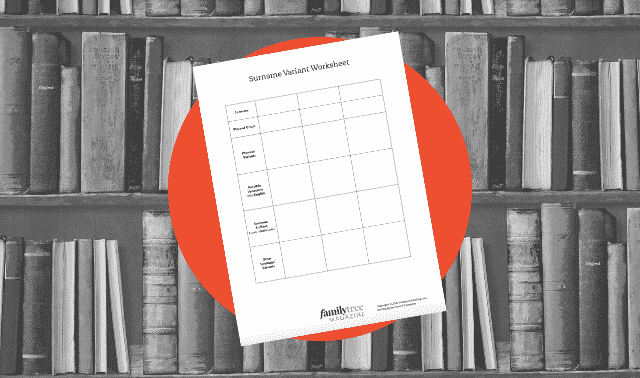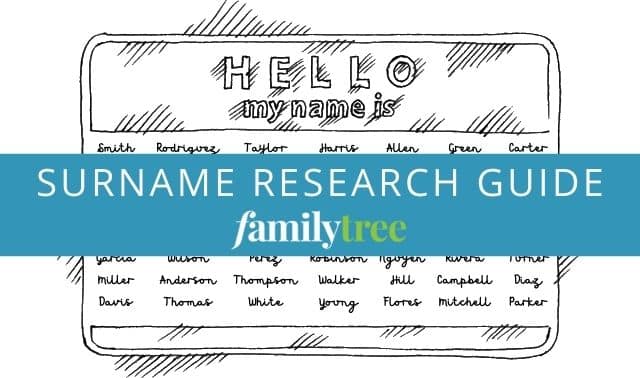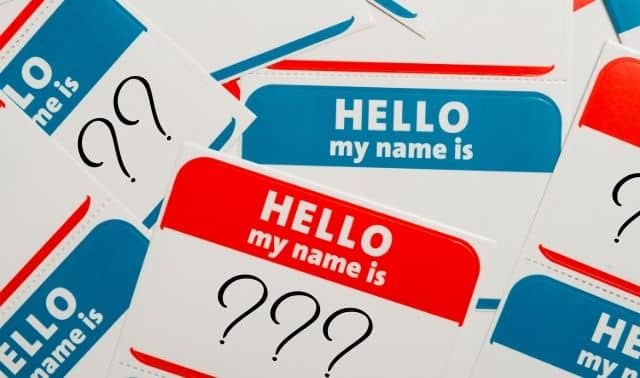Sign up for the Family Tree Newsletter! Plus, you’ll receive our 10 Essential Genealogy Research Forms PDF as a special thank you.
Get Your Free Genealogy Forms
"*" indicates required fields
How are you supposed to trace your family’s history if the names keep changing? Last names—surnames—are among the most important yet most potentially puzzling clues to your family’s past. You think you’re researching the genealogy of the Santos family and suddenly you’ve got Maria Maria. Or you have an ancestor named Sven Andersson and it looks like his son is named Magnus Svensson.
To deal with such challenges and to make the most of the answers surnames suggest, it helps to know and understand the naming practices in the cultures and geographies of your ancestors. That’s what we’ll discuss in this article.
For starters, remember that last names are a relatively recent invention. Fred Flintstone and Barney Rubble notwithstanding, humanity didn’t come out of the cave with surnames attached. In Europe, as the population began to grow in the 10th century, it became increasingly difficult to refer to someone only by a given name. Born of necessity, hereditary surnames developed gradually during the 11th through 15th centuries across Europe, generally following commercial trade routes.
Where Surnames Come From
Naming practices developed differently from region to region and country to country. Yet even today hereditary names tend to fall into one of four categories: patronymic (named from the father), occupational, nickname or place name.
According to Elsdon Smith, author of American Surnames (Genealogical Publishing Co.), a survey of some 7,000 surnames in America revealed that slightly more than 43 percent of our names derive from places, followed by about 32 percent from patronymics, 15 percent from occupations, and 9 percent from nicknames.
Often the lines blur between the categories. Take the example of Green. This name could come from one’s clothing or given to one who was inexperienced. It could also mean a dweller near the village green, be a shortened form of a longer Jewish or German name, or be a translation from another language.
In your genealogy research, you’ll likely come across most of the four main categories of surnames:
1. Patronymics
Virtually every culture seemed to have some form of patronymic system, though some relied on it more heavily than others. In Ireland, the Scottish highlands, Wales and Spain, the majority of names are patronymics; the same was true in Scandinavia, though these have additional complications that we’ll dicuss later. Here are the most common clues to patronymic names in different cultures:
- English, Scottish, Swedish: –son, as in Olaf-son; also –ing from Anglo-Saxon times as in Browning (“son of Brun,” which in turn means “brown”); also the prefix Fitz-, the Norman patronymic form as in Fitz-patrick.
- Danish, Norwegian: –sen, as in Sorensen
- Scottish: Mc or Mac, as in McCall (“son of Cachal”)
- English, Welsh: –s as in Edwards
- Irish: O’ as in O’Hara (meaning “grandson of Eaghra,” which means “bitter or sharp”)
- Welsh: use of ap, or prefix of p– or b– as in Upjohn (“son of John”) and Bowen (“son of Owen”)
- Italian: prefix of De or Di as in DeCarlo
- Ukrainian: –enko as in Kovalenko
- Spanish: –ez or –es as in Alvarez (“son of Alva”)
- Portuguese: –es or –az as in Gomes (“son of Gomo”)
- Romanian: –escu as in Tadescu
- Armenian: –ian or –yan as in Hovnanian
- Russian: –ovich as in Pavlovich
- Polish: –wicz as in Danielewicz
- Turkish: –oglu as in Turnacioglu
- Greek: –opoulos as in Theodoropoulos (“son of Theodore”)
- Hebrew: use of ben as in Ben-Yehuda
2. Occupational Names
Surnames derived from occupations figure prominently on the list of America’s most common surnames, including Smith, Miller, Taylor, Clark, Walker, Wright, Baker, Carter, Stewart, Turner, Parker, Cook and Cooper. During the Middle Ages, it was useful to distinguish John the baker from John the tailor.
The occupations were fairly common across Europe, and their use as surnames took on a decidedly local flavor. Here’s an example using Smith:
- Finnish: Seppanen
- French: Faure, Fernald, Ferris, Le Fevre, Le Febvre
- Gaelic: Gow, Gowan, Gaff
- German: Schmidt, Schmitt, Schmitz
- Hungarian: Kovacs
- Italian: Ferraro
- Polish: Kowalczyk, Kowalik, Kowalski
- Russian: Kowalsky, Kuznetsov
- Spanish: Ferrer, Herrera
- Syrian: Haddad
3. Place Names
Surnames sprang from place names in several ways: when someone was associated with or living near or by a particular hill, brook, bush, dale, valley, island, bridge, meadow, road or village; when the person was known as coming from a particular locality; and when the individual owned a manor or village. Place-derived surnames dominate in England and they’re common in Germany and France.
The first time I looked up my maiden name of Krasner in a surname dictionary, I saw that it meant either “beautiful” or “fat.” In general, there’s a big difference between how society views the two. But it wasn’t until Alexander Beider issued his comprehensive A Dictionary of Jewish Surnames from the Russian Empire (Avotaynu) that 1 learned the name actually meant someone “from the village of Krasnoe” and that it was common in certain localities in Belarus.
Bob Allen of New York City recently told me of his family name’s place-relation evolution that took an interesting turn. The original name was Greenberg or “green mountain.” When his ancestors came from Russia to America, they settled in lower Manhattan on Allen Street, named for Ethan Allen (and his Green Mountain men of Vermont), and changed their name accordingly.
Official names of towns and villages began as descriptive names given to them by neighbors, and the original bearers of surnames based on localities were inhabitants of these places. Suffixes such as –ton, –wick, –ley, –thorpe, –ham, –land and –ford described English locations. For instance, Sedgwick means “Siggi’s dwelling or dairy farm” and Stratford means “Roman road near a river crossing.” Scottish locations turned into surnames include Carmichael (“castle of St. Michael”) and Forbes (“field place”).
German and Jewish names often added an –er to the name of the locality, such as Bamberger, Danzinger or Berliner. Of course, versions of such names without the suffix also exist.
Other examples include family names based on a geographic proper name or a description of a place:
- Chinese: Li (“plum tree”), Wong (“field,” “wide sea” or “ocean”)
- Dutch: Roosevelt (“rose field”), Van Pelt (“from Pelt,” meaning “marshy place”)
- French: Cassell (“chateau” or “castle”), De Long (“from the large place”)
- German: Bremer (“from Bremen,” meaning “by the seashore”), Steinbach (“stony brook”)
- Italian: Lombard, Lombardi, Lombardo (“from Lombardy,” place of the “long-bearded men”), Napoli (“from Naples,” meaning “new city”)
- Japanese: Nakagawa (“middle river”), Tanaka (“rice field”)
- Polish: Bielski (“from Bielsk,” meaning “white”), Wisniewski (“from Wiznia,” “cherry tree”)
- Portuguese: Ferreira (“from Ferreira,” meaning “iron mine” or “workshop”), Teixeira (“place of yew trees”)
- Spanish: Cortez (“court” or “town”), Morales (“mulberry tree”), Navarro (“the plain among hills”)
In addition, a whole class of names distinguished arrivals from foreign places:
- from Flanders: Flanders, Fleming
- from England: England or Englander, Engel or Engelman (in German), Ijmghis (in French), Inglis (in Scotland)
- from Germany: Allemand (in France), Nemetz (meaning “mute” in Polish and Russian)
4. Nicknames
The word “nickname” is derived from “an eke name,” or added name. In a sense all surnames began as extra names, so technically speaking, all surnames are nicknames of one sort or another.
In our classification scheme, hereditary family names based on nicknames often describe an ancestor’s appearance (stature, hair, eyes, complexion, size), a characteristic or trait (strong, bold, brave), financial status, habits or special skills. Nickname-based names were popular in Italy and Portugal. Sometimes, this form was mixed with the patronymic system as in the Italian D’Onofrio, “son of a giant.”
Like occupational names, surnames from nicknames vary by language. So, for example, if an ancestor had red hair or a ruddy complexion, he might have been called one of the following:
- English: Read, Rede, Reed, Bay, Gough, Rudd, Ruddy, Ruff, Russ, Russell, Rust
- Scottish: Reid
- Irish: Flynn, Gooch
- French: Larousse, Rouse, Rousseau, Roux
- Germany: Roth
- Hungarian: Voros
- Italian: Pintozzi, Purpura, Rossini, Rossetti
- Slovakian: Hudak
If he had no money, he might have been known as:
- English: Powers, Poor
- Germany: Scholl
- Czechoslovakia: Chudak
Naming Practice Exceptions
Naming practices among some cultural groups don’t fall neatly into these four categories. Here are some noteworthy exceptions to keep in mind as you go surname-sleuthing:
Scandinavian
In Scandinavia, men typically bore two surnames: a patronymic and a farm name. Neither name was passed from one generation to the next. Farms formed the center of people’s lives, and if they moved from one to another, their farm-based names changed accordingly. Some farm names date back 2,000 years or more. If you see Scandinavian surnames with suffixes of –bo, –by, –gardr, –heimr, –land, –rud, –setr, –stad or –vin, it’s likely they’re derived from farms.
The patronymic form dominated Scandinavian naming practices. Children of Carl bore the surnames of Carlsen (“son of Carl”) or Carlsdatter (“daughter of Carl”) in Denmark and Norway and Carlsson or Carls-dotter in Finland and Sweden.
While this system worked well to identify the father’s given name, it wreaked havoc otherwise. In Denmark, for instance, about half the country’s inhabitants share 14 surnames. To deal with this dilemma in later years, the Swedes began to form surnames by combining two words, usually based on nature. Common names using this form include: Dablquist (“twig from the valley”), Lindstrom (“linden tree stream”) and Sundberg (“sound from the mountain”). Often just one word was used, as in the name of singer Jenny Lind. Beginning in the 20th century, the Swedish government encouraged creation of new surnames not based on the patronymic system.
Jewish
Even at the time of the mass wave of immigration from 1880 to 1920, hereditary surnames among Eastern European Jews were relatively new—maybe 100 years old or less. In their villages, they were known as “Yudel the tinsmith” or “Mendel, son of Mordechai.” For millennia, Jews had been using a patronymic naming tradition.
The Jews of Spain, who as a result of the Inquisition migrated throughout Europe, the Ottoman Empire and the Middle East, used hereditary family names as early as the 11th century. The development of these names was by choice.
Not so for their brethren in Eastern Europe. There, surname adoption was required by government edict, beginning in 1787–88 in the Hapsburg Empire, 1804 and 1835 in the Russian Empire and 1821–1825 in the Kingdom of Poland.
The process was sometimes arduous and frequently contentious. Under duress, many Jews were assigned fanciful names, like my grandmother’s name of Zuckerkandel (“rock candy”). Often, family members officially had different surnames. This brings home the notion that not all people with the same surname are related, and indeed, this bears out in most cultures.
African American
Many (but not all) enslaved people assumed the names of their enslavers or, when freed, the names of non-African Americans they knew. In this way, they adopted the predominantly patronymic surnames of the English, Welsh and Irish. Common names include Harris, Jackson, Jones, Robinson, Williams and Thomas.
Filipino
Most Filipino families only started using formal last names in 1850. This is a crucial fact in Philippine genealogy. The use of surnames came in accordance with a decree promulgated in 1849 requiring all inhabitants of the Philippines to formally adopt a single family name for their respective families. Unfortunately, this means any available website or record pertaining to a family name similar to your own does not automatically guarantee that it will be of any use.
An important, necessary first step for any Filipino genealogist is to establish, beyond reasonable doubt, that the last name you’re looking for is related to the family mentioned in the records, websites, or other sources you’re looking at. Make sure your family’s last name is a product of the decree and is the name taken from a catalog of names, or if it has always been used in their family.
Todd Lucero Sales
A version of this article originally appeared in the December 2000 issue of Family Tree Magazine.









